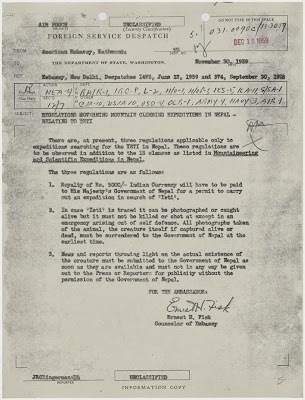 |
| Yeti Hunting anyone? |
On November 30, 1959, Ernest Fisk of the American embassy in Kathmandu delineated the Nepalese government's regulations on any mountaineer's interactions with the yeti.
From the Records of the Agency for International Development, this copy of a Foreign Service Despatch from the American Embassy in Kathmandu, Nepal, summarizes the Nepalese Government's regulations concerning any proposed mountain ...climbing expeditions in search of "YETI."
1.there is a fee to pay to Nepal's government in order to get your yeti-hunting permit.
2.that any photographs or physical remains that might be found are property of the Nepalese government and yetis must not be killed or shot at except in an emergency arising out of self-defense.
3.yeti-hunters must not share photos or evidence of yetis with any news media.
[Note: I do not know who to credit for this report or photo. Very sorry.]
Here is a photo of it.
Some said that this "Yeti Skull" turned out to be from a goat, but I don't know if that is true or not. Other suggested it was made from deer hide but again I don't know.
Also best I can remember these artifact were stolen some how and have never been found or returned. It is my understand that these artifacts have some type of religious importants to the people in Nepal.
Seems I remember something about this skull but over time I have forgot, I'll blame it on getting older.
In any case it seems the Yeti is taken somewhat serious by their government.
Thanks
~Tom~

facebook.com/TheCryptoCrew
Now you can get our blog on your Kindle!

















Tom, perhaps you should give a view to the Destination Truth hour long episode where Josh Gates actually goes there and visits the people, the "skull" etc...
ReplyDeleteWould have added a lot more to this article before you posted it unfortunately!
Yeah I remember watching that episode way back ....
ReplyDeleteWhat's more, commonly a poor shot will handicap them making them not have the capacity to search for nourishment; there is nothing more insensitive than harming a creature and abandoning it to starve to death.
ReplyDeleteLibbie C. Hass